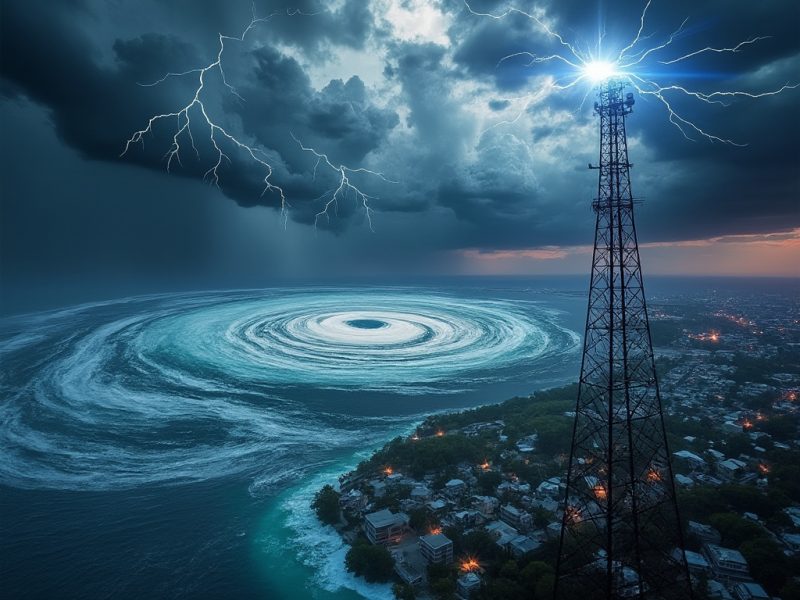As I sit here, bracing myself in the eye wall of Hurricane Milton, which is now hammering down on the Tampa Bay area, I’m reminded of the natural forces that have shaped our world for centuries. Hurricanes like this one are nothing new—storms of similar intensity have ravaged this coastline for over a century. The 1848 storm that hit Tampa took a nearly identical path with comparable strength, long before modern society began filling the atmosphere with greenhouse gases.
While I prepare for the impacts of this hurricane, I must point out that the real storm threatening our world today is not the one swirling outside my window—it’s the invisible, far more insidious force we’ve unleashed through our interference with the natural electromagnetic environment.

The Invisible Storm: Electromagnetic Pollution
What takes the world by surprise today isn’t just hurricanes or environmental disasters. It’s the explosion of physical and mental health problems deeply rooted in how we’ve altered Earth’s natural electromagnetic fields. Unlike the hurricane I face—a visible and natural force—the disruption to the electromagnetic environment is invisible, yet its impact on human biology could be significant. Decades of data suggest that the real threat we face today is the misclassification of risks associated with man-made electromagnetic fields (EMFs), particularly those emitted by wireless devices, cell towers, and the ever-expanding 5G networks.
The Hidden Disaster: Misclassification of RF Radiation Risks
Despite evidence of potential non-thermal biological effects from radiofrequency (RF) radiation, regulatory bodies have often focused primarily on thermal effects—the heating of tissues. This narrow view overlooks research indicating that RF radiation may affect our bodies on a cellular level, even at non-thermal levels. The introduction of this electromagnetic “noise” could disrupt the delicate bioelectric processes that support life. Some researchers suggest that the rise in chronic diseases, from certain types of cancer to mental health disorders, might be linked to this unseen storm.
Rats, There Is a Connection! NTP, RI, and Human Cancer Morphology
A Landmark Study: Unveiling the Biological Impacts of RF Radiation
In a landmark study published on January 17, 2024, scientists made significant strides in understanding the biological impacts of chronic RF radiation exposure. Utilizing tissue samples from the Ramazzini Institute’s animal studies, this research aimed to unravel the carcinogenic potential of RF radiation. The findings were noteworthy:
Highlight: Scientists found that tumors in rats resulting from lifetime exposure to low-dose, far-field RF radiation are morphologically similar to low-grade human gliomas.
Study Reference: Genetic Profiling of Rat Gliomas and Cardiac Schwannomas from Lifetime Radiofrequency Radiation Exposure Study Using a Targeted Next-Generation Sequencing Gene Panel.
Bridging the Gap Between Animal Models and Human Health
A common critique of animal studies is the concern over their applicability to humans. This new research directly addresses this issue by examining tissue samples from the Ramazzini Institute’s studies and identifying morphological similarities between tumors in rats and low-grade human gliomas. This suggests that RF radiation may induce cancers in animals that share significant characteristics with human cancers.
Genetic Profiling Insights
The study focused on comparing genetic mutations found in rat tumors with those present in human gliomas:
- Common Genetic Alterations: While rat tumors did not exhibit some mutations typically found in human gliomas (like IDH1 or IDH2), they shared other genetic alterations implicated in human cancer development.
- Relevance to Human Health: These similarities provide a basis for considering the results of rat studies when assessing cancer risks posed by RF radiation in humans.
Reinforcing Previous Findings
This study builds upon the groundbreaking findings of both the National Toxicology Program (NTP) and the Ramazzini Institute (RI), which independently found increased incidences of gliomas and cardiac schwannomas in rats exposed to RF radiation.
- NTP Study: Found “clear evidence” of carcinogenic activity, including brain tumors (gliomas) and heart tumors (schwannomas), in rats exposed to RF radiation.
- RI Study: Observed similar tumor development in rats at exposure levels comparable to those emitted by cell towers.
Implications for Public Health Policy
The new findings offer crucial evidence that challenges the notion that animal studies are not relevant to humans. With morphological and genetic similarities between rat tumors and human cancers now documented, there’s a stronger argument for regulatory agencies to reconsider outdated guidelines and incorporate scientific evidence pointing to potential hazards of prolonged RF radiation exposure.
Proven Links to Cancer: Key Studies Highlighting RF Radiation Risks
1. The National Toxicology Program (NTP) Study
- Scope: Largest and most comprehensive investigation into RF radiation effects on health.
- Findings:
- Male Rats: Developed glioblastoma (a deadly brain cancer) and heart schwannomas.
- Carcinogenic Activity: Demonstrated that RF radiation can lead to cancer development, even at levels considered safe for humans.
- Significance: Should have prompted an immediate update to wireless radiation safety guidelines.
2. The Ramazzini Institute (RI) Study
- Approach: Replicated the NTP study with lower exposure levels, similar to those near cell towers.
- Findings:
- Heart Schwannomas: Observed in male rats.
- Increased Malignant Tumors: Noted in exposed animals.
- Conclusion: Reinforced that RF radiation poses a real cancer risk, even at low exposure levels.
3. The BioInitiative Report
- Content: A comprehensive analysis of over 3,800 studies on EMFs, including RF radiation.
- Findings:
- Increased Cancer Risk: Particularly for brain tumors like gliomas and acoustic neuromas.
- Neurological Effects: Changes in brain function, behavior, and cognition.
- Reproductive Issues: Reduced sperm count and motility in men.
- Recommendation: Current safety limits are too high and fail to protect the public from long-term health effects.
Human Epidemiological Studies Linking RF Radiation to Cancer
The Interphone Study
- Objective: Assess whether cell phone use increases brain tumor risk.
- Findings:
- Glioma Risk: Higher risk observed in the highest exposure category (average of 30 minutes per day over ten years).
- Laterality: Tumors more likely on the side of the head where the phone was used.
The Hardell Group Studies
- Researcher: Dr. Lennart Hardell, Swedish oncologist.
- Findings:
- Increased Risk: Long-term cell phone use associated with higher risk of glioma and acoustic neuroma.
- Latency Period: Risk increased with longer time since first use.
The CERENAT Study
- Location: France.
- Findings:
- Elevated Risk: Heavy cell phone users had a higher risk of glioma and meningioma.
- Cumulative Use: Risk increased with total hours of use.
Why Most People Aren’t Aware of the Health Risks
Suppression of Scientific Evidence
Despite numerous studies indicating potential health risks from RF radiation, public awareness remains low due to:
- Corporate Influence: Telecommunications industry exerts significant influence over regulatory bodies.
- Regulatory Capture: Agencies like the FCC have been criticized for being influenced by industry interests.
- Outdated Guidelines: Current safety standards focus on thermal effects and ignore non-thermal biological impacts.
Misclassification of RF Radiation Risks
- Thermal vs. Non-Thermal Effects: Safety guidelines are based on preventing tissue heating, not on other biological effects.
- Public Misconception: Many believe that if a device doesn’t produce heat, it’s safe.
The Cost of Suppressing Science: Missed Medical Advancements
Untapped Therapeutic Potential
- RF-EMF Therapy: Research suggests RF electromagnetic fields could be used to treat medical conditions, including cancer.
- TheraBionic Device: FDA-approved treatment for inoperable liver cancer uses non-thermal RF radiation to target cancer cells.
DARPA’s RadioBio Initiative
- Objective: Explore how electromagnetic fields affect biological systems.
- Potential: Understanding natural RF communication in organisms could revolutionize medicine and telecommunications.
Non-Thermal Effects: A Bigger Threat Than Global Warming
Biological Impacts Beyond Heating
- DNA Damage: RF radiation may cause breaks in DNA strands.
- Oxidative Stress: Leads to cellular damage and aging.
- Cellular Dysfunction: Disruption of cell signaling and membrane function.
Chronic Health Issues Linked to RF Radiation
- Cancer: Increased risk of brain tumors and other cancers.
- Infertility: Impact on sperm quality and fertility rates.
- Neurological Disorders: Potential effects on brain function, including memory and learning.
Hurricanes Come and Go—Electromagnetic Pollution Stays
The hurricane outside will pass, just like storms before it. But the electromagnetic pollution we’ve introduced doesn’t dissipate on its own. We’re altering the environment that supports all life on Earth.
Disruption of Natural Electromagnetic Fields
- Bioelectromagnetics: Earth’s natural electromagnetic fields play a role in biological processes.
- Interference: Man-made RF radiation may interfere with these natural processes.
The Urgency of Action: We Cannot Wait
Protecting Future Generations
- Children’s Health: Developing brains may be more susceptible to RF radiation effects.
- Cumulative Exposure: The next generation faces higher cumulative exposure due to pervasive wireless technology.
Reassessing Safety Guidelines
- Outdated Standards: Current guidelines don’t account for non-thermal effects.
- Call for Change: Regulatory agencies must update safety standards based on current scientific understanding.
Actionable Steps
Minimizing Personal Risk
- Limit Exposure: Reduce time spent on wireless devices.
- Use Alternatives: Opt for wired connections when possible.
- Safe Device Use: Use speaker mode or earphones to keep devices away from the head and body.
Advocacy and Awareness
- Stay Informed: Keep up with the latest research.
- Public Engagement: Encourage open discussions about RF radiation risks.
- Support Research: Advocate for independent studies on long-term health effects.
Conclusion
I may lose power as this storm continues to rage, but before that happens, I want to leave you with this critical message: The time for action is now. We cannot continue to overlook potential dangers posed by RF radiation. The evidence is mounting, and the stakes are too high to ignore.
By acknowledging the scientific findings—from animal studies showing morphological similarities to human cancers, to epidemiological studies linking cell phone use to increased cancer risk—we can push for necessary changes in safety guidelines and public awareness.
It’s imperative that we protect not just ourselves but future generations from this invisible storm. Let’s not wait for the damage to become irreversible. The health of our children, and their children, depends on the actions we take today.








